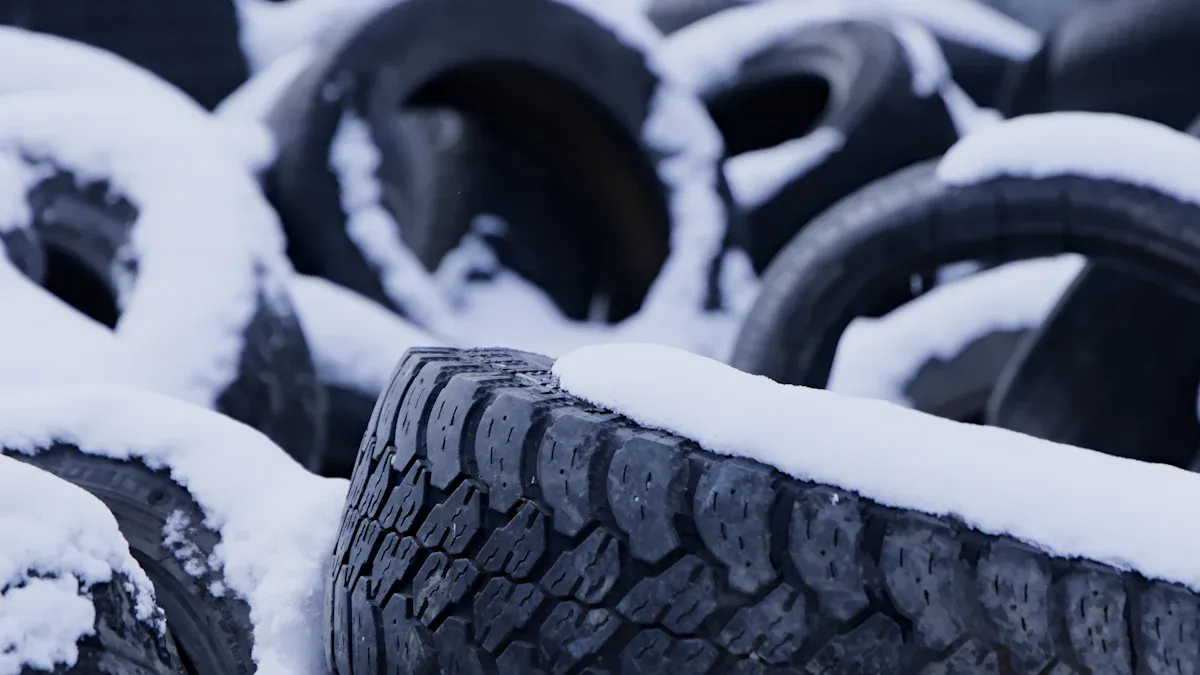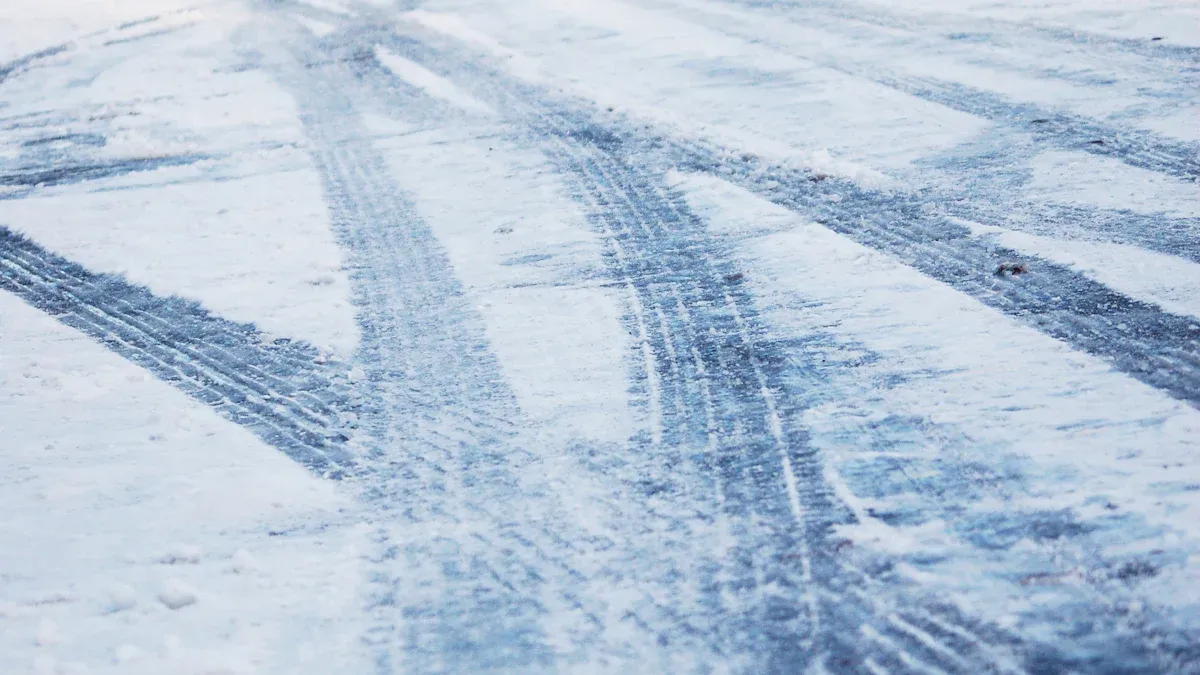
Rubber Tracks for Snow provide outstanding traction and flotation on icy terrain. Operators trust their wide surface area and flexible rubber construction for safe, reliable movement. Advanced tread patterns reduce slippage and protect surfaces. These tracks keep machinery efficient and secure during winter operations.
Key Takeaways
- Rubber tracks provide excellent grip and flotation on snow by using wide, flexible designs and advanced tread patterns that reduce slipping and improve safety.
- These tracks protect surfaces by spreading machine weight evenly, preventing damage to snow, soil, and paved areas while offering a quieter, smoother ride for operators.
- Proper maintenance, including regular inspections and cleaning, helps rubber tracks last longer and perform reliably in cold winter conditions.
Key Features of Rubber Tracks for SnowAggressive Tread Patterns for Maximum Grip
Rubber Tracks for Snow use advanced tread patterns to deliver outstanding grip on icy and snowy surfaces. Deep, aggressive lugs dig into soft snow, providing both traction and flotation. Siping, which means adding small slits to the tread blocks, creates extra biting edges. This design helps the tracks grip icy surfaces and shortens braking distances by up to 30%. Directional tread patterns, such as V-shaped grooves, channel snow and water away from the contact area. This keeps the tracks clear and improves handling.
Operators can choose from several tread designs to match their needs. For example, straight-bar patterns offer the most aggressive traction, while zigzag and multi-bar patterns balance grip and comfort. The Terrapin tread pattern stands out for its ability to reduce vibration and ground disturbance while still providing excellent grip on snow.
| Tread Pattern | Traction on Snow | Ride Comfort | Notes |
|---|---|---|---|
| Straight-Bar | Aggressive, best for deep snow | Lower | Prioritizes traction |
| Zigzag | Versatile, effective in snow | Smooth | Good for multiple surfaces |
| Multi-Bar | Good flotation and traction | Smoother | Balances grip and comfort |
| Terrapin | Excellent on uneven/wet surfaces | High | Reduces vibration and ground disturbance |
Wide and Long Track Design for Enhanced Flotation
Wider and longer tracks help machines stay on top of soft snow instead of sinking. These tracks spread the machine’s weight over a larger area, lowering ground pressure. For example, a 400 mm wide track creates a contact area of over 1,000 square inches, reducing ground pressure to just 3.83 PSI. This means better flotation and less risk of getting stuck.
- Wider tracks distribute weight, lowering ground pressure.
- Lower ground pressure prevents sinking into snow.
- Operators experience fewer problems with soft terrain.
- Wide tracks also reduce ground disturbance and rutting.
| Track Width (in) | Contact Area (in²) | Ground Pressure (psi) |
|---|---|---|
| 12.60 | 639.95 | 6.58 |
| 15.75 | 800 | 5.26 |
Choosing the right track width and length ensures reliable performance in deep snow. Kubota rubber tracks, for example, offer a range of sizes to match different machines and snow conditions.
Flexible Rubber Compounds for Low Ground Pressure
Rubber Tracks for Snow use special rubber compounds that stay flexible even in freezing temperatures. This flexibility allows the tracks to conform to uneven snow and ice, improving grip and reducing slippage. Flexible tracks also spread the machine’s weight more evenly, which lowers ground pressure and helps preserve the snow surface. Winter-optimized rubber compounds keep their performance in temperatures as low as -25°C, making them ideal for harsh winter environments.
Durable Materials for Winter Longevity
Manufacturers build Rubber Tracks for Snow with high-quality materials to resist cracking and wear in cold weather. They use natural rubber for elasticity and tear resistance, and Styrene-Butadiene Rubber (SBR) for abrasion resistance and temperature stability. Special additives protect the tracks from UV rays and ozone, preventing surface cracks. These materials ensure the tracks remain flexible and strong, even in subzero temperatures.
| Material Component | Role in Snow Rubber Tracks | Effect at Subzero Temperatures |
|---|---|---|
| Natural Rubber | Provides elasticity, tear resistance, tensile strength | Maintains flexibility, prevents brittleness and cracking |
| Styrene-Butadiene Rubber (SBR) | Enhances abrasion resistance and temperature stability | Ensures stability and prevents hardening in cold weather |
| Specialized Rubber Compounds | Maintain flexibility and grip across temperature extremes | Enable consistent performance in winter frost |
| UV Stabilizers and Antiozonants | Protect against environmental damage (UV, ozone) | Prevent surface cracking caused by environmental factors |
Kubota rubber tracks use these advanced materials and designs to ensure long-lasting performance in winter conditions.
Shock Absorption and Operator Comfort
Rubber Tracks for Snow provide excellent shock absorption. Their flexible design spreads the machine’s weight and reduces vibration. This leads to a smoother, quieter ride and less operator fatigue, even during long hours in the cab. Compared to steel tracks or tires, rubber tracks create less noise and vibration, making them the best choice for comfort and efficiency in snowy environments.
Operators notice the difference right away. Rubber tracks cushion the ride, reduce noise, and help them stay focused and productive all day.
Kubota rubber tracks feature a walking system that delivers low noise, small vibration, and a comfortable ride. This system is especially useful for machines that need to move quickly between job sites and operate on all types of terrain, including snow.
Rubber Tracks for Snow vs. Metal Tracks and Tires

Traction and Stability Comparison
Rubber Tracks for Snow deliver steady traction on icy and snowy ground. Their advanced tread patterns grip the surface, helping machines move forward without slipping. Metal tracks also provide strong traction, but they can dig into the snow and create uneven paths. Tires, especially winter tires, use special treads and sometimes metal studs for grip. Studded tires work well on ice but can damage pavement and make loud noises. Rubber tracks keep machines stable and safe, even when the snow gets deep or the ground turns slippery.
Flotation and Surface Protection
Rubber tracks spread the weight of a machine over a wide area. This design helps the machine float on top of soft snow instead of sinking. Metal tracks without rubber pads do not protect surfaces as well and can leave marks on roads or concrete. Rubber pads on steel tracks, like Fusion and Stealth systems, improve flotation and protect delicate surfaces. The Stealth rubber Over-The-Tire system stands out for its ability to glide over loose snow and sand. Tires with wide treads can also help with flotation, but they may lose traction on ice. Rubber tracks protect the ground and keep snow surfaces smooth.
Field reports show that rubber tracks prevent deep ruts and soil compaction. Their flexible material bends and absorbs bumps, leaving gentle trails and preserving the snow.
Safety and Comfort Differences
Rubber tracks offer a quiet and comfortable ride. They absorb shocks and reduce vibration, which helps operators stay alert and safe. Metal tracks create more noise and vibration, making long hours in the cab tiring. Tires can bounce on rough ground, causing discomfort and less control. Rubber tracks keep the ride smooth and help operators focus on their work. This comfort leads to better safety and higher productivity during winter operations.
Practical Benefits of Rubber Tracks for SnowReduced Surface Damage and Land Disturbance
Rubber Tracks for Snow protect the ground during winter work. Specialized tread patterns, like Terrapin and TDF Multi-Bar, increase surface area and grip snow and ice without digging into the earth. These tracks spread weight and traction evenly, which keeps machines stable and prevents deep ruts. Operators see less damage to lawns, paved areas, and sensitive terrain. The tracks glide over snow, leaving a smooth surface behind. This benefit makes them ideal for jobs where preserving the ground matters.
Improved Safety and Efficiency in Snow Operations
Operators choose rubber tracks for safer and faster work in snowy conditions. These tracks boost traction and stability, helping machines move confidently on slippery ground. They lower ground pressure, which keeps machines from sinking and makes operation safer on soft snow. Rubber compounds absorb shocks and vibration, so operators stay comfortable and alert. Advanced tread designs grip snow and clean themselves, reducing slippage and making engine power more effective. Machines run quietly, which helps operators focus and communicate. Longer track life and fewer breakdowns mean more time working and less time fixing.
- Better grip and stability on snow and ice
- Lower ground pressure for safer movement
- Shock absorption reduces fatigue
- Self-cleaning tread improves productivity
- Quiet operation supports safety and teamwork
- Durable tracks cut down on maintenance
Maintenance and Longevity in Cold Conditions
Rubber tracks last longer when operators care for them properly. Regular inspections catch problems early, like worn treads, cracks, or missing lugs. Operators check track tension and alignment often, especially in cold weather. Cleaning tracks after use removes salt and chemicals that can damage rubber. Premium tracks last between 1,200 and 2,000 hours, or about 2-3 years with normal use. Cold climates can make rubber brittle, so choosing tracks with winter-ready compounds helps. Operator training and good driving habits also extend track life.
| Maintenance Aspect | Description |
|---|---|
| Visible Tread Wear | Worn treads lower grip and need replacement. |
| Cracks and Cuts | Fine cracks signal aging; deep cuts weaken tracks. |
| Missing or Damaged Lugs | Broken lugs cause slippage and less efficiency. |
| Deformation and Stretching | Warped tracks do not fit well and wear faster. |
| Exposed Cords or Steel Belts | Exposed reinforcement means the track is near failure. |
| Loss of Traction | Less grip signals tread wear. |
| Unusual Noises | Squeaks or grinding mean damage or poor fit. |
| Frequent Tension Adjustments | Stretching tracks need more tension and may be near end of life. |
| Excessive Vibration | Rough ride shows uneven wear or damage. |
| Track Alignment | Misalignment affects sprocket life and track wear. |
Operators who follow these steps keep their Rubber Tracks for Snow working longer and safer, even in tough winter conditions.
Rubber Tracks for Snow deliver unmatched grip, flotation, and durability in winter. Operators gain better mobility, stability, and surface protection.
- Superior traction and maneuverability on snow
- Reduced ground damage compared to metal tracks
- Strong market growth driven by high adoption rates
Choose Rubber Tracks for Snow for reliable, safe winter performance.
FAQ
How do rubber tracks perform in extreme cold?
Rubber tracks stay flexible in temperatures as low as -25°C. They keep machines moving safely and efficiently, even in harsh winter weather.
Can rubber tracks damage paved surfaces?
Rubber tracks protect paved surfaces. They spread weight evenly and prevent scratches or ruts. Operators trust them for snow removal in parking lots and driveways.
What maintenance do rubber tracks need in winter?
Operators should clean tracks after use, check for cracks, and adjust tension. Regular care extends track life and keeps machines running smoothly all season.
Media Contact
Company Name: Gator Track Co., Ltd.
Email:Send Email
Country: China
Website: https://www.gatortrack.com/
